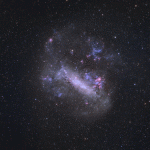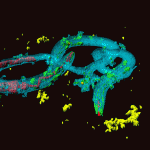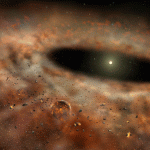
The North Star is a triple star system, with the main North Star, Polaris, confirmed as a Cepheid Variable. Image: NASA, ESA, N. Evans (Harvard-Smithsonian CfA), and H. Bond (STScI)
New research suggests that the North Star could disappear.
Earth’s North Pole is aligned with Polaris’ position in the night sky, making the star appear motionless. However, this is a long way from the truth — Polaris is actually a Cepheid variable; a type of star that pulsates and varies in size and luminosity over a period of days. It’s also losing mass.
Recent observations have indicated that the star ejects large amounts of its mass into space. Using 170 years worth of observations of the star and stellar evolution models, scientists from the University of Bonn, Germany, have found that it is actually losing mass at a significant rate.
“The change of mass of the Cepheid or mass loss directly affects the change of pulsation period,” Dr Hilding Neilson says. “This is because the physics that describes the pulsation of a Cepheid is the same physics that can describe a standing standing wave in a string — the period of a standing wave in a string depends on the length of the string and its tension.”
When it was first suspected to be a variable star in the 19th century, Polaris had a shorter pulsation period than it does today. Every year, its time between pulses has lengthened by an average of eight seconds, causing Neilson and his colleagues to begin investigating the relationship between pulsation periods and mass loss.
They used Polaris’ parameters, well known from years of observations, together with a computer model to predict the rate of change for the pulsation period. However, the rate predicted did not correspond with the rate observed over the past 170 years.
“We compute rates of period change for the theoretical models and find that they completely disagree with observed rate for Polaris, where the observed rate is measured from observations spanning more than a century. The theoretical rates are just too small,” Neilson says. “This means that there is some physics missing from the theoretical models and the best candidate to explain the difference is significant mass loss, up to an Earth mass per year.”
The researchers tweaked their calculations to reflect a loss of mass equivalent to that of Earth and found that the predictions of Polaris’ rate of period change closely resembled the observational data, they reported in the Astrophysical Journal Letters. However, this may not be the only answer — Richard Strothers suggested in a 2009 study that a slow change in the star’s magnetic field could affect convection and hence periodicity.
No matter what the cause, Polaris will not be disappearing from the night sky in the near future. “This mass loss will not drastically affect the evolution and structure of Polaris,” Neilson says.
“The amount of time that Polaris will continue to be a Cepheid is probably less than one million years, meaning that Polaris will lose only a small fraction of its total mass.”






